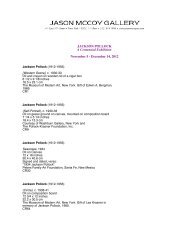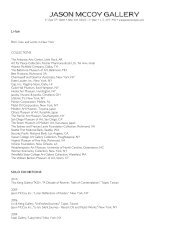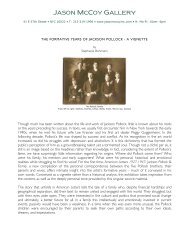JACKSON POLLOCK - Jason McCoy Gallery
JACKSON POLLOCK - Jason McCoy Gallery
JACKSON POLLOCK - Jason McCoy Gallery
You also want an ePaper? Increase the reach of your titles
YUMPU automatically turns print PDFs into web optimized ePapers that Google loves.
of Orange Head, the central shape evokes shamanistic African<br />
or Native American Indian masks, as well as Picasso’s portraits<br />
of the time. The overall sensibility of emotional turmoil<br />
also relates to the half-human, half-grotesque portraits of a<br />
very different artist, Francis Bacon (1909–1992). The collage<br />
The Mask (scr 24) 4 also embraces a figurative presence. Here,<br />
a helmet-like shape made of fabric, originally a pattern for<br />
two sides of the head of a rag doll, is contrasted with an array<br />
of fine and loosely rendered creatures. Harvested from a personal<br />
mythology, they only emerge fractionally. Their meaning<br />
is not symbolic, as that would imply conscious intent.<br />
Only their pictorial presence on paper is concrete.<br />
Pollock’s explorative journey of the unconscious was intensified<br />
through the Surrealist practice of automatic writing<br />
and drawing. Through Robert Motherwell, Pollock was introduced<br />
to Peggy Guggenheim. Her Art of this Century gallery<br />
was not only home to many European Surrealists, but it would<br />
also become the venue of Pollock’s first solo show in November<br />
1943. 5 Motherwell further invited Pollock to join a group led<br />
by Roberto Matta, which was dedicated to exploring Surrealist<br />
techniques and for about two months met regularly. Whereas<br />
Jung’s theories and automatism provided Pollock with a method<br />
to access the imagery rooted in his unconscious, he found<br />
stylistic inspiration and the level of intensity he was striving<br />
for, in the works of Pablo Picasso and Joan Miró. The unparalleled<br />
vehemence of raw emotions in Picasso’s Guernica (1937),<br />
which captured the horrors of war in a language both utterly<br />
moving and clear, captivated Pollock to the extent that he completed<br />
several Equine paintings in 1944. 6 In contrast, Miró’s<br />
influence is especially traceable in another group of paintings,<br />
also from 1944, including Night Ceremony (cr 106), Night<br />
Mist (cr 104), The Night Dancer (cr 105), and Night Sounds<br />
(cr 111). Manifesting as meditations on nocturnal landscapes<br />
and the mysteries they can behold, these works evoke Miró<br />
particularly in regards to palette and treatment of form. Like<br />
Guernica, Pollock had been able to study Miró’s work at the<br />
Museum of Modern Art, where a retrospective was held from<br />
1941 to 1942. In Night Sounds, a crescent moon dramatically<br />
illuminates the surrounding darkness. The composition is flat,<br />
resembling a chalkboard rather than a night sky, onto which<br />
ominous symbols foreshadowing the loose notations of a Jean-<br />
Michel Basquiat have been drawn in pastel. Krasner recalled<br />
that the moon was a topic, which she and Pollock discussed<br />
often. 7 It is a theme rich in polarities. The contrast between<br />
light and dark, concrete and dissolving imagery, can serve as<br />
a metaphor for nature’s tidal rhythms of clarity and mystery.<br />
10<br />
In 1945, Krasner and Pollock moved from Greenwich<br />
Village closer to nature, settling near the Atlantic Ocean in<br />
Springs on Long Island. At first, Pollock had painted in the<br />
house, but by late 1947 an outside barn was cleared and converted<br />
into his studio. 8 Painted in 1947, [Composition with<br />
Black Pouring] (cr 170) foreshadows two of Pollock’s most<br />
distinguished bodies of work: his “classical” abstractions of<br />
1949–50, as well as his black-and-white paintings of 1951–<br />
52. This composition can either be read abstractly, when focusing<br />
solely on the overall sense of rhythmic movement, or<br />
concretely. Upon close inspection, the black line drawing,<br />
which seems to float above the vivid silvery background, takes<br />
on the outline of a figure. This dichotomy, which is based on<br />
the interplay of distinct paint layers, would become heightened<br />
in the black-and-white paintings.<br />
It was in his new studio that Pollock began to increasingly<br />
experiment with his materials. He tilted cans, used wooden<br />
sticks, brushes and even turkey basters to paint more freely.<br />
Occasionally, he added sand and glass for texture. Canvases<br />
were laid directly on the floor and, as Hans Namuth’s photographs<br />
and film of Pollock at work (1950–51) reveal, he<br />
began to draw in space, motioning in the air above the paintings’<br />
surface. This technique allowed for an unusual time lapse<br />
between the act of painting and its manifestation on canvas.<br />
Pollock thought thoroughly about technique. In 1949, he<br />
listed some of the desired attributes on a scrap piece of paper:<br />
“total control—denial of the accident—states of order—organic<br />
intensity—energy and motion made visible—memories<br />
arrested in space, human needs and motives—acceptance—.” 9<br />
A year later, in an interview with William Wright, he clarified:<br />
“My opinion is that new needs need new techniques.<br />
And the modern artists have found new ways and new means<br />
of making their statements. It seems to me that the modern<br />
painter cannot express this age, the airplane, the atom bomb,<br />
the radio, in the old forms of the Renaissance or of any other<br />
past culture. Each age finds its own technique.” 10<br />
Pollock’s pouring technique has frequently been linked to<br />
jazz. In an interview with Barbara Rose, Krasner recalled how<br />
Pollock “would sometimes listen four or five consecutive days<br />
and nights to New Orleans jazz until I would go crazy. The<br />
house would be rocking and rolling with it.” 11 In jazz as much<br />
as in Pollock’s work, improvisation is a key component, but<br />
it is never arbitrary. It follows a sense of structure. The same<br />
is true for nature and its seasons, which may vary in length<br />
and intensity from year to year, but which will follow each<br />
other reliably. In Springs, the natural landscape and the close








